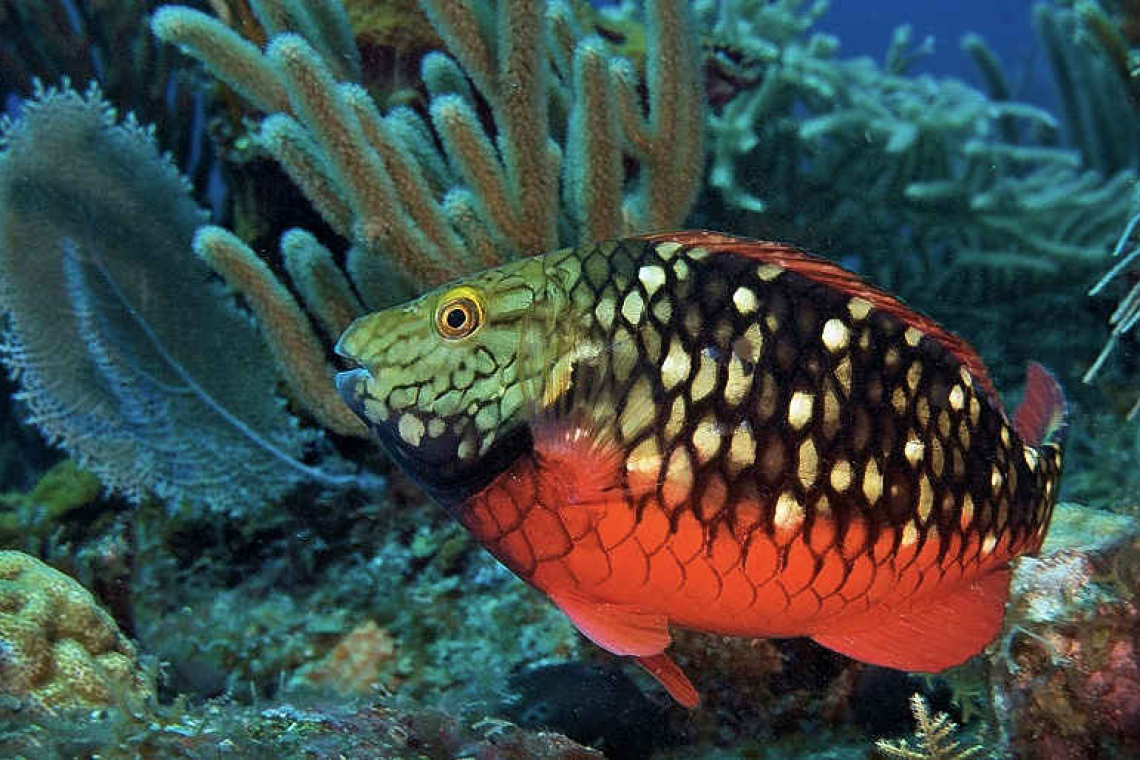From the DCNA, Photo credit: Marion Haarsma.
Parrotfish are more than just a pretty face. The average parrotfish spends up to 90% of its day cleaning the coral reefs. Their sharp beaks allow them to easily scrape algae off corals and rocks, essential for keeping the reefs healthy and thriving. Especially now with major stressors such as coral bleaching events and Stony coral tissue loss disease (SCTLD), they are important for helping coral reefs to recover and regrow. Increased protection in the Caribbean region [are-ed.] considered in the next Conference of parties for the Cartagena Convention (COPS) meeting [April 20-21 – ed.] on Aruba.
Coral reefs provide valuable habitat for fish and other animals. People also benefit from the many ecosystem services coral reefs provide, including coastal protection, food and income from tourism and fisheries. In fact, coral reefs are one of the most important sources of income for the Dutch Caribbean islands.
Important grazers
Herbivores like parrotfish play a critical role in maintaining healthy coral reefs. They help sustain the delicate balance within the reef by grazing on (macro) algae, which are the main competitors for corals for space and light. The average parrotfish spends up to 90% of its day cleaning the reef. Not only does this fish species keep the algae in check, but these herbivores also create new space for baby corals to attach and grow.
Besides removing macroalgae and promoting coral settlement and growth, parrotfish are also natural bioeroders producing sediment by grazing on rocks, calcareous algae and corals (less than 10% of their food). Hereby they help recycle nutrients and produce “sand” for (eroded) coastal areas.
The Global Coral Reef Monitoring Network (GCRMN) report entitled “Status and Trends of Caribbean Coral Reefs: 1970-2012” by Jackson et al. (2014) documented quantitative trends on coral reef health over 43 years in the wider Caribbean. The report identifies that one of the major drivers of coral reef decline in the Caribbean is the overfishing of herbivores, particularly parrotfish.
Threats
Parrotfish thrive best in healthy coral reefs ecosystems. Therefore, these fish are subjected to the same threats as corals. This includes the negative effects of climate change, ocean acidification, pollution and diseases such as the Stony coral tissue loss disease (SCTLD). In addition, overfishing can quickly wipe out local parrotfish populations. Studies show that reefs are healthier and have a higher recovery resilience capability in locations where parrotfish are protected. This highlights the importance of parrotfish for reefs to be able recover and regrow from these threats.
Protecting Parrotfish
In the Dutch Caribbean – on Aruba and Bonaire – there are local rules and regulations to protect all parrotfish. On these islands, it is prohibited to catch, kill, wound, or disturb them. Luckily for the other islands in the (Dutch) Caribbean, the Kingdom of Netherlands, along with the Republic of France, has formally submitted a proposal to include all parrotfish in Annex III of the Specially Protected Areas and Wildlife (SPAW) Protocol, a regional agreement for the protection and sustainable use of coastal and marine biodiversity in the Wider Caribbean Region. If approved during the next Conference of parties for the Cartagena Convention (COPS) IGM20/COP17 later this year on Aruba, this measure provides a legal framework for the conservation of the parrotfish to ensure and maintain population at an optimal level in the Wider Caribbean.
Want to learn more about local parrotfish populations? Check out the following related articles: “Fish poop: an underappreciated food source for coral reef fishes?”; “Recovery of Orbicella annularis corals from parrotfish predation”; and “Parrotfish key to reef survival”, available via the website https://dcnanature.org/; and “Proposal Parrotfish SPAW Annex III” available via www.gefcrew.org.







